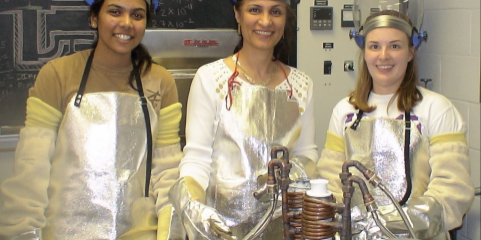The Advanced Materials Research Lab (AMRL) at North Carolina State University is creating a new class of metallic foam, known as composite metal foam (CMF), to combine the benefits of metal matrix composites and metallic foams. In the past decade, the focus has been on developing the technology to process the CMFs through both powder metallurgy and casting techniques and compare the properties of the products administered using each technique with other metal foams. The CMF has up to 7-8 times higher energy absorption compared to any other metal foam made from similar materials and its energy absorption is almost two orders of magnitude higher under loading compared to the original bulk materials. For example, a CMF made out of stainless steel can have a third of the density of bulk steel but can offer two orders of magnitude higher energy absorption under compression. This makes the composite metal foam an ideal candidate for application in various safety devices and structures such as armors, cars and trains, helicopter landing gears, nuclear structures, biomedical devices, and more.
Rabiei and her team explored the radiation shielding efficiency of CMFs for the attenuation of X-rays, gamma rays, and neutrons by experimenting and comparing the results with bulk materials, such as pure lead and the aluminum alloy A356. The addition of small quantities of high-Z elements to CMFs improved their radiation shielding capability while still maintaining their low density, high mechanical properties, and high-energy absorption capability. Additionally, CMFs are more effective for X-ray attenuation than aluminum. Compared to pure lead, CMFs show comparable attenuation with the additional advantages of being lightweight and environmentally friendly. These lightweight, energy-absorbing CMFs could potentially be used as shielding material to replace the heavy materials currently used for radiation shielding. CMFs could be utilized in military applications and space exploration for structural support, protection against high impacts, and shielding for various forms of radiation. [1]
Recent studies by AMRL also revealed a superior thermal resistance and fire survivability of CMFs. The CMFs offer extremely good thermal insulation, superior thermal stability, and excellent flame retardant performances as compared to commercially available materials such as stainless steel. These desirable characteristics of CMFs mean they could be used for applications that require superior thermal insulation and stability such as nuclear spent fuel casks and fire retardants.
Other potential applications of CMFs are in blast and ballistic armors. The National Institute of Justice (NIJ) Standard—0101.06, “Ballistic Resistance of Body Armor”, is a technical document that specifies the minimum performance requirements that armor systems must meet in order to satisfy the requirements of criminal justice agencies and the methods used in order to test this performance. [2] The results of Rabiei’s experiments showed that CMFs were able to absorb the major portion of the total kinetic energy of projectiles effectively in addition to stopping both types of type III and type IV (armor Piercing) projectiles with less depth penetration and backplate deformation than that specified in the NIJ 0101.06 standard guidelines. [3] Further studies on the capability of CMFs to protect against larger threats and blasts are still ongoing.
In addition, high-speed impact testing for automotive and trains application showed very high energy-absorption capabilities at a variety of impact speeds from quasi-static up to 100 meters per second. [4] This indicates the potential for utilizing CMFs in crash energy management systems in trains, cars, buses as well as the impact protection for tank cars, to protect the tank contents, such as chemicals or other hazardous materials, in the event of a derailment or accident.
References:
[1] Rabiei, A. & Shipman, M. (2015). Study finds metal foams capable of shielding x-rays, gamma rays, neutron radiation. NC State News. Retrieved https://news.ncsu.edu/2015/07/rabieifoam-rays-2015/
[2] Ballistic resistance of body armor: NIJ standard-0101.06. (2008) U.S. Department of Justice. Retrieved from https://www.ncjrs.gov/pdffiles1/nij/223054.pdf
[3] M. Garcia-Avila, M. Portanova, A. Rabiei, “Ballistic performance of composite metal foams,” Composite Structures, 125, (2015), pp. 202-211.
[4] Y. Alvandi-Tabrizi, D. A. Whisler, H. Kim, A. Rabiei, “High strain rate behavior of composite metal foams,” Materials Science and Engineering: A, 631, (2015), pp. 248-257.


